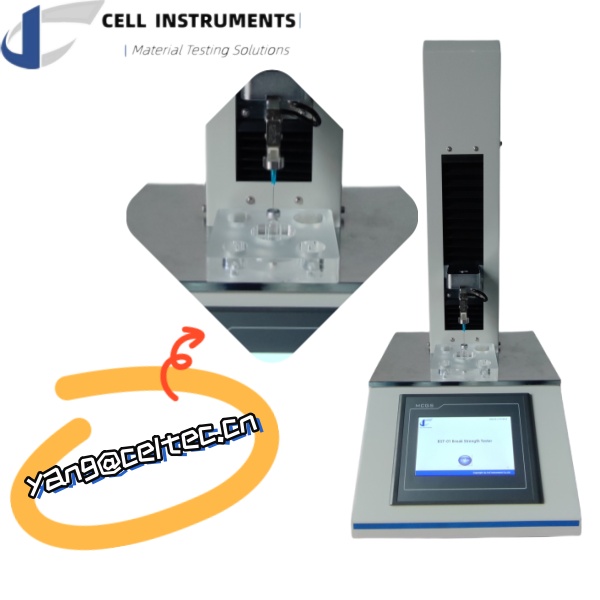Needle Penetration Test Method for Rubber Stoppers
Needle penetration test method assesses the penetrability of rubber stoppers, ensuring they can be pierced by needles within the suitable force.
1. Understanding Rubber Stopper Penetrability
According to ISO 8871-5, penetrability denotes the force required for penetrating an elastomeric closure. The standard delineates the testing process as follows: Many pharmaceutical elastomeric closures are utilized alongside injection needles. Assessing the force necessary for penetration is critical in determining the closure’s suitability for its intended application. The testing protocol includes fixing the injection needle and seal onto the instrument, applying vertical force until penetration, and documenting the maximum force.
2. Overview of ISO 8871-5 and USP 381 Standards
Both ISO 8871-5 and USP 381 provide comprehensive guidelines for testing the functional requirements of elastomeric parts used in pharmaceutical applications.
ISO 8871-5: Titled “Elastomeric parts for parenterals and for devices for pharmaceutical use – Part 5: Functional requirements and testing,” this standard outlines the testing conditions, including the apparatus and procedures for assessing the functional properties of rubber stoppers. It emphasizes the need for precision in measuring penetration force and depth, ensuring consistent and reproducible results.
USP 381: Known as “Elastomeric Closures for Injections,” this standard specifies the physical and chemical tests required for rubber closures used in injectable products. It includes guidelines on the needle penetration test, focusing on the conditions under which the test should be performed and the criteria for acceptable results.
3. Needle Penetration Test Method Procedure
To conduct a needle penetration test, certain preparatory steps and precise procedures must be followed to ensure accuracy and compliance with ISO 8871-5 and USP 381.
Pre-test Preparations
Selection of Rubber Stoppers: Choose representative samples that reflect the production batch.
Conditioning and Storage Requirements: Store samples under specified conditions to maintain their properties prior to testing.
Testing Apparatus
- ISO 8871-5 Requirements: The test equipment must be capable of accurately measuring penetration force and depth. It should include a fixture to hold the rubber stopper and a needle holder to control penetration speed.
- USP 381 Requirements: Similar to ISO 8871-5, the apparatus must ensure consistent application of force and precise measurement capabilities.
Testing Procedure:
- Mounting the Rubber Stopper: Secure the stopper in the testing fixture.
- Needle Specifications: Use needles that meet the standard specifications in terms of gauge, length, and material.
- Penetration Speed and Force: Control the penetration speed (as per the standard) to simulate actual usage conditions. Measure the force required to penetrate the stopper.
- Measurement of Penetration Force and Depth: Record the force at which the needle pierces the stopper and the depth of penetration to assess compliance with the standards.
Data Collection and Analysis:
- Recording Results: Automatic and output by Cell Instruments NPT-01 Penetrability Tester.
- Interpreting Results: Compare the results against the acceptable range defined in the standards. Identify any deviations that may indicate issues with the rubber stoppers.
4. Equipment Recommendation: Cell Instruments’ NPT-01 Penetrability Tester
Cell Instruments, a leader in materials testing instruments, offers the NPT-01 Penetrability Tester, designed to meet the stringent requirements of ISO 8871-5 and USP 381.

Features of the NPT-01 Penetrability Tester:
- Compliance with Standards: Fully adheres to ISO 8871-5 and USP 381 guidelines, ensuring reliable and standardized test results.
- Advanced Automation and Precision: Automates the testing process, reducing human error and increasing reproducibility.
- User-friendly Interface and Customizable Settings: Offers easy operation and flexibility to adjust testing parameters according to specific requirements.
Benefits of Using the NPT-01:
- High Accuracy and Repeatability: Delivers consistent and precise measurements, essential for maintaining product quality.
- Enhanced Efficiency: Streamlines the testing process, saving time and resources.
- Support and Service: Cell Instruments provides comprehensive support and maintenance services, ensuring optimal performance of the tester.
5. Case Studies and Applications
Real-world applications of needle penetration testing underscore its critical role in ensuring product safety and effectiveness.
- Pharmaceutical Applications: In the pharmaceutical industry, ensuring the integrity of injectable drugs is paramount. Needle penetration tests validate that rubber stoppers can be reliably pierced without compromising sterility or efficacy. For instance, a leading pharmaceutical company implemented the NPT-01 Penetrability Tester to enhance its quality control process, resulting in improved product reliability and compliance with regulatory standards.
- Medical Devices: Medical devices that require precise and sterile components benefit significantly from needle penetration testing. A case study involving a manufacturer of syringes and infusion sets demonstrated that using the NPT-01 Tester improved their quality assurance protocols, leading to better product performance and customer satisfaction.
8. FAQ
Q1: What is the significance of needle penetration testing for rubber stoppers?
A: Needle penetration testing ensures that rubber stoppers can be pierced by needles without compromising sterility or causing contamination, which is crucial for the safety and efficacy of injectable drugs.
Q2: What standards govern the needle penetration test method?
A: The primary standards are ISO 8871-5 and USP 381, which outline the functional requirements and testing procedures for elastomeric parts used in pharmaceutical applications.
Q3: What equipment is recommended for needle penetration testing?
A: Cell Instruments’ NPT-01 Penetrability Tester is highly recommended as it complies with ISO 8871-5 and USP 381 standards, offering precision, automation, and user-friendly features.
Q4: How does the NPT-01 Penetrability Tester enhance the testing process?
A: The NPT-01 enhances the testing process by providing accurate, repeatable measurements, automating the procedure to reduce human error, and offering customizable settings to meet specific testing requirements.
References
ISO 8871-5 standard documentation
USP 381 standard documentation
Related Articles
Needle Puncture Resistance Testing
Penetrability Testing
Penetrability Tester
Penetrability Test
Needle Penetration Test Equipment
Penetration Force Tester
Needle Penetration Test for Vial Stopper
